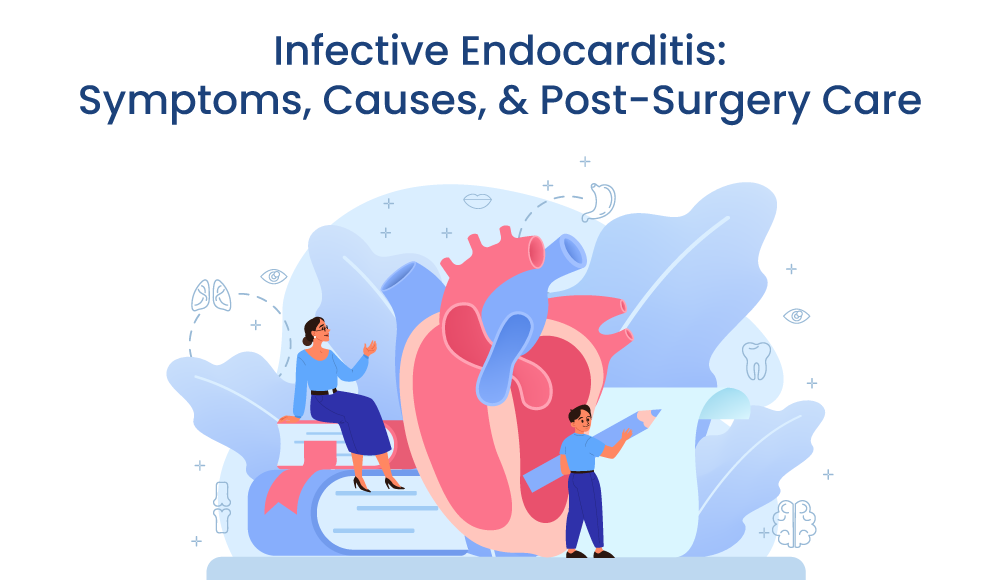Infective Endocarditis is a condition characterized by an infection that affects the inner heart valves and heart chambers, specifically the endocardium. It typically occurs as a result of bacterial infection, and less commonly, fungal infection.
Understanding the signs of endocarditis, its causes, and post-surgery care is imperative since it can help in the early recognition and diagnosis of the disease, leading to better treatment outcomes. Knowing the root causes helps prevent future occurrences. Post-surgery care ensures proper healing, reduces complications, and enhances overall recovery.
In this post, you will gain comprehensive knowledge about infective endocarditis. By delving into its symptoms, causes, and post-surgery care, you will develop a thorough understanding of this condition.
Need expert advice on Infective Endocarditis? Schedule your appointment now
A] Understanding Infective Endocarditis
Infective Endocarditis, also known as a valve infection, happens primarily because of a bacterial infection. The bacteria can enter the blood through the mouth, skin, intestines, urinary tract, and respiratory systems. Once the bacteria enters the blood, it can attach to and attack heart valves.
When infective agents settle on the heart valve, they can trigger the growth of abnormal structures known as vegetations. These vegetations release substances that can gradually affect the health of the valve tissue, which may, in some cases, lead to the development of a perforation. Additionally, these substances have the potential to extend beyond the heart, exacerbating the overall impact and severity of the condition. Hence, it is vital to understand the signs and symptoms of infective endocarditis, as it can have severe consequences if left untreated.
B] Symptoms Of Infective Endocarditis
To gain a comprehensive understanding of infective endocarditis, it is important to be mindful of its infective endocarditis symptoms. While some of these symptoms may appear ordinary, it is crucial not to dismiss them and instead investigate further. Here are a few key symptoms to remember and consider:
- Fever, sweating, and chills are among the common ones. It can be around 100 F or above and may come and go, especially at night.
- You may see red rashes on the skin.
- Small areas of bleeding, especially under the nails.
- Shortness of breath and tiredness.
- Swelling in the abdomen, feet, or legs.
- Persistent cough, especially dry, lasts for more than two days.
- Instances of diarrhea, nausea, and vomiting.
- Sore or scratchy throat with difficulty during swallowing.
- Weight loss and poor appetite.
- Muscle and joint pains.
Infective Endocarditis can be life-threatening if not treated, and early diagnosis can prevent heart valve damage and other serious complications. Now, let’s take a look at some of the common infective endocarditis causes.
C] Causes And Risk Factors Of Infective Endocarditis
Bacterial infection is among the most common cause of infective endocarditis. Besides, it can also happen due to a fungal infection known as candida, while in some situations, it may be difficult to find the root cause. Furthermore, the infective agent can also enter the bloodstream through:
- Central venous access line.
- Use of unclean or unsterile injection needle.
- Dental or other surgeries or procedures through the breathing tract, infected skin, urinary tract, muscles, or bones.
Additionally, besides the common causes of endocarditis mentioned above, the below-listed people are always a high risk:
- People with artificial heart valves.
- Someone with a heart defect since birth.
- Individuals with abnormal or defective heart valves.
- People with a history of endocarditis.
- Use of long-term IV lines.
- Intravenous drug addiction or disorder.
- When a pacemaker may be instilled in the heart.
- Someone with suppressed immunity.
- Hypertrophic cardiomyopathy is a condition that thickens the heart muscle and makes it difficult to function properly.
D] Precautions To Prevent Infective Endocarditis
Here are some simple precautions one can take to prevent infective endocarditis:
- Maintaining good oral health as it reduces the chances of bacterial infection. Start by regularly brushing & flossing your teeth. Also, get regular dental checkups.
- If you plan to get body piercings or tattoos, make sure to choose a reputable establishment that follows strict hygiene practices, including the use of sterilized equipment.
- Avoiding the use of dirty or non-sterile injection needles as they can lead to bacteria entering your bloodstream and causing infective endocarditis.
- Immediately seek your doctor if you develop any symptoms of infection, especially fever, unexplained fatigue, or any open wounds that don’t heal.
- Inform healthcare providers about your condition, especially If you have a history of infective endocarditis, heart valve disease, or other heart conditions, make sure to inform all healthcare providers involved in your care. This includes dentists, physicians, and surgeons.
E] Treatments For Infective Endocarditis
When caught early on, a healthcare specialist will effectively carry out infective endocarditis treatment with the help of antibiotics that are given through IV. However, if the damage caused by the infection is severe, your doctors might suggest going for infective endocarditis surgery, which can help save your life. Below are the two common surgeries:
1. Commando Operation With Reconstruction Of Aorto-Mitral Curtain
The aorto-mitral curtain reconstruction is known as the commando procedure. It is generally done when the aorto-mitral curtain and aortic and mitral valves are also damaged or infected. The AMC or aorto-mitral curtain is a complicated structure contributing to the fibrous skeleton of the heart. Therefore, in such a case, replacing just both valves does not help to eliminate the infection entirely. Hence, different techniques using the pericardial patches are used to reconstruct the aortic-mitral continuity.
2. Hemi-Commando With Reconstruction Of Aorto-Mitral Curtain
Dr. Jose Navia at the Cleveland Clinic has introduced a new technique to combat the situation of infective endocarditis. It is known as hemi-commando operation or incorporated aorto-mitral homograft. In this, only the aortic valve and repaired the mitral valve with tissues taken from the transplanted segments of the donor’s heart. In this treatment of infective endocarditis, both heart valves are not replaced.
F] After Surgery Care
Recovery post infective endocarditis surgery can take anywhere between four & eight weeks depending upon the severity of the surgery. As soon as the surgery happens, the patients are advised on what diet to follow, medicines to take, and exercises to do, if any. Understanding the infective endocarditis aftercare is essential as it can help recover better and quicker.
The patients will also be told how to resume their normal activities, and they should follow the advice of their cardiovascular surgeon in Mumbai. Following their doctor’s recommendation will help them lead a healthy life and circumvent costs of heart transplant surgery.
G] What To Expect During Infective Endocarditis Diagnosis?
During your doctor’s visit, you will be told to describe your detailed symptoms to the doctor to make an accurate diagnosis. If they feel you have infective endocarditis, they will suggest a blood test, especially CBC, to check for anemia. It is used to check for any storage of red blood cells that may have led to infective endocarditis.
Your doctor can also suggest a heart ultrasound or echocardiogram and electrocardiogram to check for your heart’s activity. In case your reports are positive, you will be admitted immediately to the hospital for treatment.
Conclusion
Infective endocarditis can be fatal and life-threatening if not treated on time. People can be treated using antibiotics through IV lines with the proper diagnosis. But in case of severe damage, doctors will suggest going for infective endocarditis surgery, which is of two types and done per the patient’s situation. You should consult with a heart specialist if you may have experienced any of the symptoms mentioned above.
Furthermore, you have been advised to undergo infective endocarditis surgery. In that case, it is crucial to comprehend the costs of valve repair surgeries thoroughly and strictly follow the post-surgery care instructions to minimize the risk of complications.
Need expert advice on Infective Endocarditis? Schedule your appointment now





[…] Our guide shares signs of endocarditis, its causes, & post surgery care. Reading it can help you better manage your condition. […]